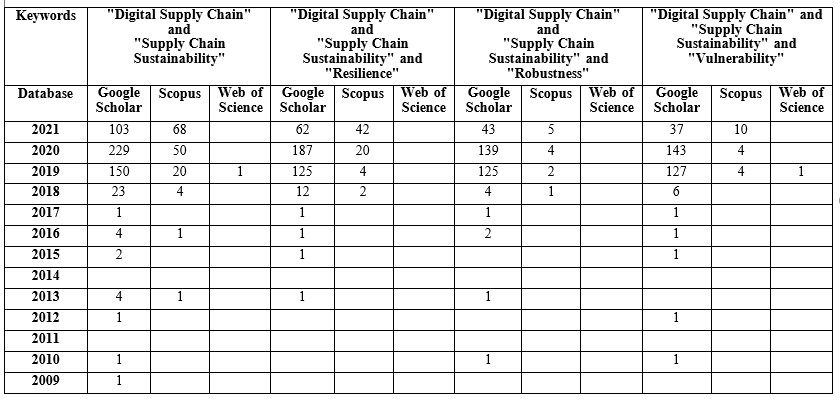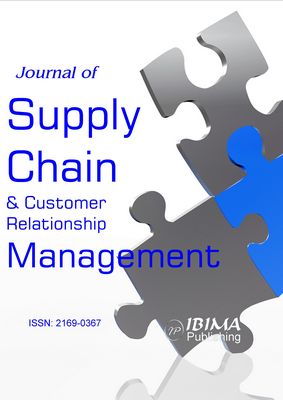Introduction
The COVID-19 epidemic was announced as a pandemic in March-2020 (WHO, 2020a) (WHO, 2020b). As a reaction to the spread of the pandemic, governments globally imposed new policies as countermeasures, such as social distancing and lockdowns (Balasa, 2020). As a consequence, supply chains got disrupted and following delays occured based on missing, late-coming, and incomplete deliveries (Chen, Wang and Zhong, 2021). In the second quarter of 2020, many European countries went into a complete lockdown and applied instruments to avoid unemployment (Su et al., 2021). Companies had to think of dismissing employees that were without work in the current situation. The state stepped in by paying part of the wage of the employee. Such policies have been researched e.g. in Italy, Germany, and Norway (Cook and Grimshaw, 2020).
Still in 2021 with the third COVID-19 wave in Europe, lockdowns were applied, also forcing companies to remain in home office frameworks or to send people on forced and government-subsidised holiday (Molloy et al., 2021). This further tightened the situation. With missing deliveries from Europe and from other countries caught in lockdown, deliveries were not able to suite the required delivery date and companies further downstream in the supply chains were affected directly (Ivanov and Das, 2020). This resulted in the lack of supply of several goods on the market, such as wood (Sprecher und Kleijn, 2021) and computer chips (Dosi, Federico and Virgillito, 2021).
A further development that took place in the course of the years 2020 and 2021 was the increase of the container prices. Relations from China to Europe, such as Shanghai-Rotterdam and Shanghai-Genoa, were increasing by 400 to almost 550% (Drewby, 2021). A further increase of the container prices cannot be excluded. Hence, this provides difficulties for companies relying on the cheap transport opportunities from Asia to Europe. Supply chains under fierce price competition may suffer from the container price increases, even more if the price remain on a high level or will continue to rise.
Supply chain risk management (SCRM) should secure supply chains against disruptions and uncertainties (Sreedevi and Saranga, 2017). In order to avoid spread of risks in supply chains, the whole supply chain tries to develop policies and mitigation strategies to prevent negative outcomes of the supply chain (Chang, Woojung and Ellinger and Blackhurst, 2015). Risk targeted may be understood in cultural differences, in physical distances, and also in the issues resulting during transportation (de Souza Feitosa, Carpinetti and de Almeida-Filho, 2021). Due to the changing risk framework over time, the focus in SCRM varies (Kumar et al., 2021a). With regard to the COVID-19 pandemic disruptions, there might be the need to change the view on SCRM and its mitigation strategies.
While the the research focus goes towards sustainable supply chains (SSC) and green supply chains (Kumar, Singh and Kumar, 2021) in order to conquer the environmental trends of the time, the rise of container, resource, and component prices on the world market raises the question of whether supply chains will not change their sourcing strategies. By putting a higher weight on the risk inhibited in the location of sourcing, regionalization strategies might again come into focus, not only for individual companies, but also for whole supply chains. Hence, it is a question of whether in the aftermath of the COVID-19 pandemic the sourcing strategies of those companies will go regional.
Literature Review
Mitigating risks arising from disruptions is part of the SCRM (Ivanov, 2018) that can be distinguished into operational and disruptional risk management. While the operational risk management focuses on daily-occurring risks of incomplete batch deliveries and time delays, the disruptional risk management targets risks that may be categorised to have a high impact (Singh and Hong, 2020). These risks have a low probability to occur (). In integrated supply chains this leads to a ripple effect (Dolgui and Ivanov, 2021), where primarily company-internal risks spread to put the whole supply chain at risk. As such, the supply chain integration may provide the ground for the risk spreading (see figure 1).
Disruptions are seen as the core of SCRM. Thus, these disruptions require a strategy to not be prepared for the inhibited risks to occur (DuHadway et al., 2019). SCRM is understood to provide strategies for the mitigation of risks. Hence, it puts focus on reducing supply chain vulnerability (Rangel, de Oliveira and Leite, 2014). This should ensure the continuous flow of materials and information through the supply chain as planned, not falling prey of the risks. Each individual company has to develop its own strategy based on its actual reality to target the risks it is exposed to (Revilla and Saenz, 2017), while supply chains have to search for a concept that wants to reduce the risk for the whole supply chain (Aqlan and Lam, 2015).
Supply chains represent open systems (Kast and Rosenzweig, 1972) that are characterised by a given extend of uncertainty (Mackay, Munoz and Pepper, 2019). By enlarging the system through global supply chain integration, the degree of uncertainty is also rising (Chaudhuri, Boer and Taran, 2018), as all supply chain-internal factors have to be taken into consideration. This calls for an approach of risk management that is able to cover the uncertainties of the whole chain to make it against disruptions. Small and medium-sized companies (SMEs) have to be taken into close consideration, as these companies might have limited abilities to conquer risks (Kauppila, 2015). Due to their constraints in human, financial, and technical resources (Mittal et al., 2018), these companies lack skills in risk management.
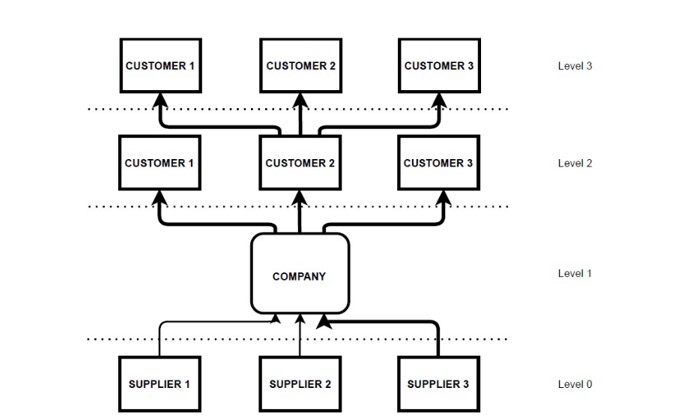
Figure 1: Corruption and attack distribution through the supply chain (Pfeifer, 2021)
Today’s supply chains are usually able to cover operational risks due to their resilience (Lücker and Seifert, 2017). However, disruptional risks arising in crisis time are subject of the supply chain robustness, where the current COVID-19 pandemic development shows disruptions all over the globe (Flynn et al., 2020). Various industries, such as the food industry, the computer industry, as well as automotive were not able to cope with the sudden changes of the legislation changes during the pandemic and their aftermaths (Katsaliaki, Galetsi and Kumar, 2021). The potential to mitigate those disruptions is small, as upstream suppliers will affect the other supply chain members and the suddenness of those events does not allow for a robust strategy (Kirilmaz and Erol, 2017).
With rising concern on environmental issues, the supply chain sustainability and green supply chains. With a first publication in 2007, the terms of sustainability and of a green focus were intertwined in the approach towards reaching an environmentally-concerning approach of the supply chain from its process beginning to its end (Srivastava, 2007). This activities are not limited to manufacturing and logistics, but begin already in the designing and proposal processes where crucial decisions are taken (Martins and Pato, 2019). As such, green supply chain management represents a concept to reduce negative outcomes on the environment (Kannan, Sasikumar, and Devika, 2010). However, legislation-wise, there are different country-specific frameworks that do not yet set the same standards (Rühl, 2021).
Different motives exist in supply chains to go for a green way of working, such as a) building a green image (Zhu and Cote, 2004), b) pressure from citizens or c) country legislations (Lin, Chen and Nguyen, 2011) and d) the need to secure supply chain working for the long-term. Depending on the region of production and service, the availability of traditional resource is limited or inhibits a high extent of risk. An example might be shortages in electricity supplies, as studies in India showed (Jayaram and Avittathur, 2015). Hence, the greening may therefore present a side effect than a primary supply chain strategy.
Already in 2009, the United Nations Department of Economic and Social Affairs (UNDESA) presented its strategy for a global green economy, called “Global Green New Deal“. This strategy focused on the reduction of negative outcomes on the environment through economic regulation. It assumes, that green supply chains may be one component to leads to an overall green economy (Li et al., 2015). While the green economy goes far beyond, the green supply chain may play a crucial part in meating environmental and ecological targets.
Green supply chains may be understood to put a further burden on the member companies, as they have to follow additional requirements (Green et al., 2012). However, the studies has shown that the switch towards green supply chain principles may also lead to the creation of a competitve advantage (Barratt, and Oke, 2007) (Subir, 2009). Through cooperation, a green multiplier effect might be achieved, enabling members of the supply chain to profit from the advanced environmental level of the supply chain partners (Preuss, 2001). While studies have been done on the topic of green and sustainable supply chains, authors did not find evidence that a higher environmental and green performance would lead to a higher degree of environmental sustainability (Zhu, Sarkis and Lai, 2008) (Vachon and Klassen, 2006).
Researchers anticipate that the current COVID-19 pandemic might not only bring disruptions in supply chains, but also provide companies with the opportunity to implement changes (van Hoek, 2020). Sustainable supply chains might be considered to provide a limited approach to spare extensive non-sustainable resource exploitation (United Nations, 1987). However, there seems to be no general evidence that sustainability limits companies as such (Martins and Pato, 2019). Another viewpoint focuses on the understanding of sustainability as an integration of economic, environmental, and social aspects into supply chains (Ahi and Searcy, 2013).
Sustainable supply chain definitions went beyond the green supply chain definitions as far as their characteristics are concerned. While green supply chain characteristics focused on environment, flow, and coordination. Sustainable supply chain involved additional characteristics such as relationships (Haake and Seuring, 2009), stakeholders (Seuring and Müller, 2008), and performance (Carter and Rogers, 2008). Having been understood as a reactive framework to target negative outcomes, sustainability is understood today as a proactive strategy to guide and lead events and supply chains to the desired outcome (Giunipero, Hooker and Denslow, 2012).
While sustainability focuses on long-term aspects of the supply chain, the supply chain risks against disruptions are not targeted (Fahimnia and Jabbarzadeh, 2016). Concerning supply chain sustainability risks, Giannakis and Papadopolous claim that those should be targeted individually, separated from other supply chain risks (Giannakis and Papadopolous, 2015). Further, research found that little focus has been put on supply chain innovation with regard to sustainability and SCRM (Kusi-Sarpong, Gupta and Sarkis, 2018). These innovations may provide a measure for resilience and adaptability with regard to fending off disruptions.
While in recent years, the prevailing research content focused on the further integration of supply chains, the digitalization with the help of digital twins (Burgos and Ivanov, 2021), the vulnerability and resilience of supply chains, as well as green and sustainable supply chains (Farooq et al., 2021), a smaller trend focused on the research on the localisation of supply chains. These authors assume a development towards de-globalisation (Antrás, 2020), regionalisation (Enderwick and Buckley, 2020) and a “Slowbalisation“ (Irwin, 2020) (Pegaro, Propris and Chidlow, 2020). Jetin assumes that a supply chain regionalisation in Asia has already begun prior to the COVID-19 pandemic and the accompanying crisis events (Jetin, 2020). While the debate on the relation between globalisation and regionalisation is ongoing, authors may also claim that regionalisation is an extended aspect of the globalisation of supply chains (Chen, Miao and Li, 2021).
This paper wants to have a look, whether the amount of literature published may suggest an increasing research focus on the regionalisation of supply chains in the future.
RQ1: Is there an increasing literature during COVID-19 as a hint for regionalisation, localisation and deglobalisation together with supply chain sustainability and green supply chains?
RQ2: Do keywords, such as resilience, robustness and vulnerability, appear in publication the same frequently throughout the years?
Methodology
With regard to the trends published in the recent years, this article wants to have a look on the literature published with respect to sustainable supply chains, green supply chains, and regionalisation, globalisation, and deglobalisation. Therefore, this paper wants to have a look into the three different databases Web of Science (WoS), Scopus, and Google Scholar to assess the amount of papers published. With pre-determined key words that will be used for all three databases, the databases should provide comparable results for further analysis. In order to have papers with a primary interest in the topic, the research has a look on papers where the key words were found in the full text.
Further, in order to assess the publication activities on supply chain sustainability and green supply chain. In order to evaluate this publication activity, a supporting measure is defined as the ratio of the number of publications for each of the two keywords. This ratio is counted for a) the category title and abstract and b) for the full text.
In a second step, the retrieved data from the databases will be assessed with statistical analysis. For this, the database results will be categorised by the year of publishing in order to assess the trend of publishing from the years 2009 to 2021. This time period begins after with the economic crisis in the first decade of the century while it also includes the beginning of the COVID-19 pandemic.
The statistic analysis applies the analysis of variances (ANOVA) and the Levene-test in order to assess the similarity of mean values and variances in the acquired samples. The ANOVA is used to assess the signifikance of differences of the mean values of publication numbers associated with the key words >>“Supply Chain Sustainability“ and >>“Green Supply Chain“<<. With the help of the Levene-test, this paper assesses the significance of equal variances of the number of published papers in the different databases based on the year of publication. Further, with the help of ANOVA and Levene-test, this paper wants to have a look whether >>“Digital supply chains“<< are showing rising publications with >>“Supply Chain Sustainability“<< or >>“Green Supply Chain“<< and the risk-management terms >>“Robustness“<<, >>“Resilience“<< or >>“Vulnerability“<<.
The whole statistical analysis is conducted with a significance level of p < 0.05
Sample
The sample consists of three tables derived from the databases Google Scholar, Scopus, and Web of Science with the keywords >>“Supply Chain Sustainability“<< and >>“Green Supply Chain“<<. Data was taken for the full text (table 1). from the beginning of July 2021. Due to the minor differences in search results found (+/- 10 papers), a further extension of the keyword query of >>“Supply Chain Sustainability“<< >>”Supply Chain Sustainability” and (“Regionalisation” OR “Slowbalisation” OR “deglobalisation”)<< did not bring any further knowledge and was neglected for further analysis. The same was also derived for the relation of the queries >>“Green Supply Chain“<< and >>” Green Supply Chain” and (“Regionalisation” OR “Slowbalisation” OR “deglobalisation”)<<.
Table 2: Number of publications in databases based on keyword finding in full text (own processing)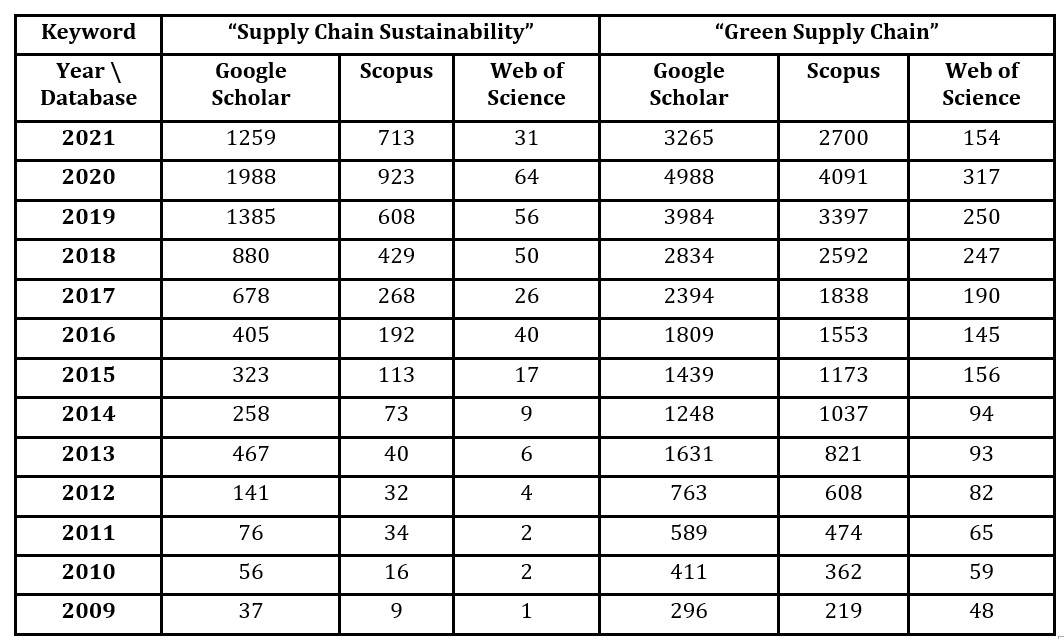
Further data derived from the database is the ratio of the number of publications found for the two categories. Table 2 shows this ratio for searching a) only in abstract and title and b) for the full text. The ratios have been calculated as the ratio of number of publications for >>“Green Supply Chain“<< divided by the number of publications for >>“Supply Chain Sustainability“<< for each year from 2009 to 2021.
Table 2: Ratio of number of publications in databases (own processing) 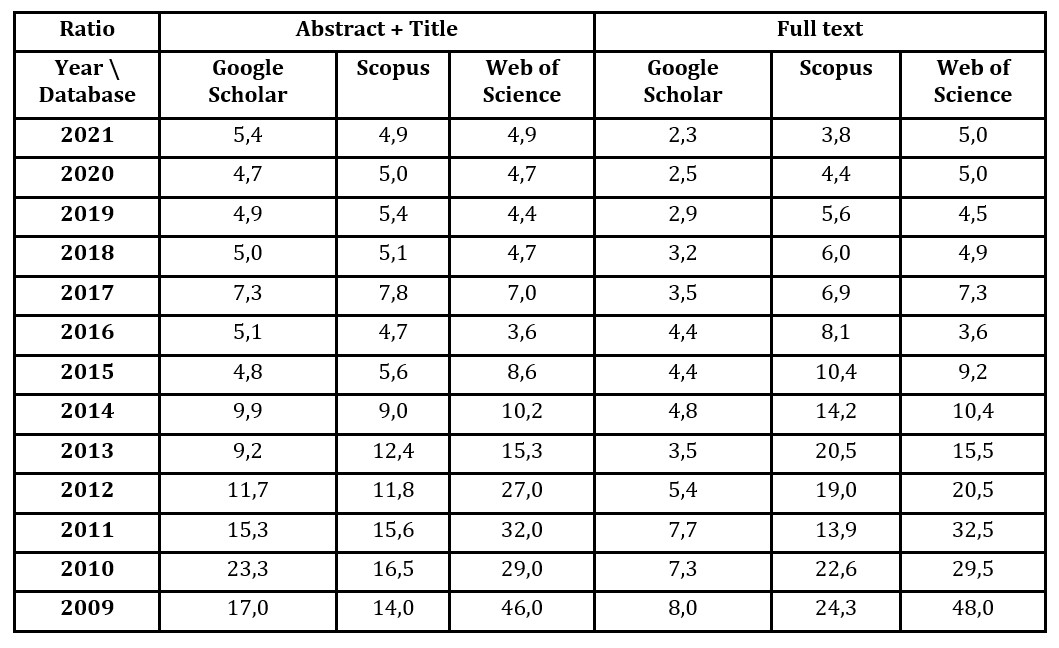
Research
The ANOVA test was conducted with a degree of freedom of 51. Table 3 shows the results stating that the hypothesis H0 of the same means of different years from 2009 to 2021 has to be rejected. Instead, the H1 hypothresis of the significantly differing means in the years from 2009 to 2021 is accepted. Due to the steadily rising tendency of the publications for both key words, as well as for the ratio of publications of the two key words, the expected a steadily-rising and growing interest in the topic. However, during all the time, the term >>“Green Supply Chain“<< >>“Supply Chain Sustainability“<< showed a higher frequency and had constantly higher numbers of publications.
Research showed that the analysis for a) abstract and title and b) for full text publications show the same outcome.
Table 3: ANOVA test for the mean of the number of publications throughout the databases by publication year (own processing)
The Levene-test is also conducted with 51 degrees of freedom. However, for all keywords the H0 hypothesis is accepted, while the H1 hypothesis is rejected. This suggests that for both keywords, as well as for the ratio of the keywords the variances of publications throughout the years are same in all three analysed databases. Thus, the tendency of rising numbers of publications is expected in all three databases while the variances seem to be same on the p < 0.05 significance level.
Table 4: Levene-test for the variances of the number of publications throughout the databases by publication year (own processing)
The Levene-test shows a pattern for the variances. The variances for the different keywords show significant differences for the keywords as well as for the analysis of the keywords. Therefore, it may be understood that the number of publications including >>“Supply Chain Sustainability“<< is rising with faster speed than >>“Green Supply Chain“<<. The topic of Sustainability is coming more into focus in the recent years.
For the third research hypothesis, the ANOVA test was conducted in order to have a look on additional keywords, namely >>“Vulnerability“<<, >>“Resilience“<< and >>“Robustness“<< as SCRM-related terms in combination with further keywords, such as >>“Supply Chain Sustainability“<< or >>“Green Supply Chain“. As digital supply chains accompany real supply chains with a digital twin and are of ever rising importance for supply chains with regard to industry 4.0 and the required real-time data exchange. The corresponding frequency tables may be found in appendix A, table 7 and table 8. The outcome of the ANOVA test are presented in table 5 and table 6. Table 5 and table 6 evaluate only numbers from Scopus and Google Scholar. Due to the small numbers of publications in Web of Science, these numbers cannot be used for statistical analysis.
Table 5: ANOVA-test for keyword combination for Google Scholar and Scopus publications (own processing)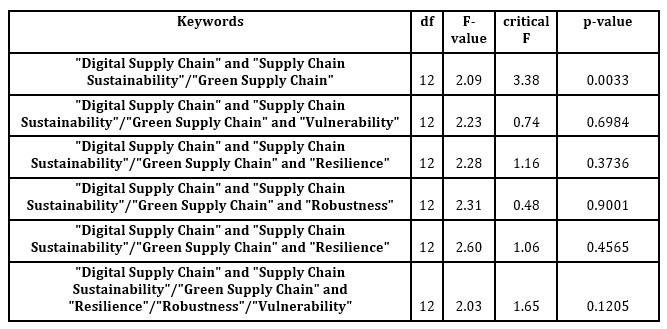
The sample found significant differences in the mean values of the keywords including >>“Digital Supply Chain“<<. These differences may be found for all keywords, also in combination with resilience, robustness, and vulnerability separately and together. As found before, green supply chains show a higher average amount of publications than sustainable supply chains. Thus, the before-found trend does also not change when further related keywords belonging to the SCRM topic are taken into account.
While table 5 focuses on the ANOVA analysis of keywords based on different databases, table 6 has a look on the year-wise data.
Table 6: Levene-test for keyword combination (own processing)
Table 6 shows that >>“Resilience“<< and >>“Resilience“ OR “Robustness“ OR “Vulnerability“<< paired with >>“Supply Chain Sustainability“<< and with >>“Green Supply Chain“ show the same variances within a p < 0.05 significance value. >>“Vulnerability“<< and >>“Robustness“<< showed a significantly different variance. Thus, while >>“Resilience“<< seems to be the terms >>“Vulnerability“<< and >>“Robustness“<< show a higher variance and different means for “Supply Chain Sustainability“<<. Thus, it may be concluded that these two terms are discussed more with >>“Digital Supply Chain“<< than >>“Resilience“<<. It seems, that supply chain resilience in the last years was lost from focus, while supply chain robustness and vulnerability got increasing popularity.
Summing up the research, it may be said:
H1: rejected. It cannot be concluded that the number of publications in the databases are equal for the years 2009 to 2021.
H2: accepted. >>“Supply Chain Sustainability“ and >>“Green Supply Chain“<< show significantly equal variances throughout the databases and years.
H3: acepted. >>“Robustness“<< and >>“Vulnerability“<< show significant differences in means and variance for >>“Supply Chain Sustainability“<<.
Discussion
While green supply chains are understood to be only one aspect of sustainable supply chains, the literature on green supply chains in all analysed databases prevails. Depending on the search field criteria, there are roughly four to six times as much papers for “green supply chain“ than for “sustainable supply chain“ in the recent years. However, all computed ratios show a constant decline from 2009 to 2020 which may indicate a rising interest in the full aspect of sustainable supply chains.
The ANOVA test shows that the means of publication numbers in the three databases differ significantly from each other in the given years. And this applies for the keywords as well as for the given ratio of publications for the keywords. Even though, the H1 hypothesis has to be rejected indicating no equal means of the sample, the Levene-test hereafter suggests that the variances of the samples are equal. Thus, while the means differ, the varainces of the sample suggest a trend for the keywords, as well as for the ratio. This trend in all the three databases assumes a faster increase of >>“Supply Chain Sustainability“<< literature than of >>“Green Supply Chain“<< literature.
Further ANOVA and Levene-tests show an increasing focus of literature towards supply chain robustness and towards supply chain vulnerability in recent years. Recent development seemed to go away from short-term resilience, concentrating primarily on long-term robustness. However, deglobalisation and regionalisation are only rarely present in the supply chain literature. Data suggests that digital supply chains, paired with green aspects and the robustness and vulnerability may be the main research topics in supply chain management for the next years.
The increase of publications in these areas proposes a growing interest in the subject of sustainability and green aspects in supply chains. However, further aspects with regard to the stability of supply chains, such as resilience, robustness, and visibility, do not yet show a significant increase against the usual topics of the primary keywords. With this aspect, it will be interesting to see whether the supply chain disruptions due to the Asian container crisis will have a further impact on the publication activities in the analysed fields.
Conclusion
The recentness of events did not yet lead to a sudden increase in the number of publications in the field of supply chain sustainability or green supply chains paired with terms such as slowbalisation, deglobalisation, and regionalisation. Till date, there is no evidence that these terms would have received higher attention in the COVID-19 economic crisis. While some researchers suggested the deglobalisation and regionalisation as a slow-down of the globalisation already before this crisis, it must be said that no evidence in this could be found by the conducted analysis. While supply chain disruptions took place in 2020 and 2021 in the course of the pandemic, the meta-analysis of the publication activity does not yet suggest a significant difference to the pre-COVID-time. A potential explanation could be the fact that the descriptive scientific articles may come with a delay due to the current situation.
Concerning the amount of publications in databases, the three chosen databases show significantly different mean values of the number of publications in the databases for the years 2009 to 2021. These values differ throughout all three databases with respect to the years of analysis. On the other hand, the Levene-test suggests the variances of the different database samples to be equal. Thus, there seems to be a general trend in these three databases of simultaneously increasing numbers of publications for “Supply Chain Sustainability“ and “Green Supply Chain“. While publication numbers are highest in the Google Scholar database, also the higher-ranked databases Scopus and Web of Science show similar trends of increasing publication activity in this area. Even though the current pandemic could not be found as the initial shocking trigger yet, the interest towards sustainability and green aspects in supply chains got a broader focus in recent years. Rising interest was suggested by analyzing all three databases.
With the current situation and supply chain disruptions, it will be interesting to see the future development of these supply chains and how they will deal with the COVID-19 pandemic and its aftermath. While supply chains seem to be resilient to a certain extend against short-term disruptions, these chains have to prove whether they are also robust enough to overcome the aftermath of the current situation. Recent years have shown a rising interest in this research and publication area. Strategies to facilitate the robustness and to ensure supply in the case of pandemic events may provide a future need for supply chains to react and for research.
References
- AHI, P. and SEARCY, C. (2013). A comparative literature analysis of definitions for green and sustainable supply chain management. Journal of Cleaner Production, vol 52, p. 329–341.
- AQLAN, F. and LAM, S. S. (2015). Supply chain risk modelling and mitigation. International Journal of Production Research, vol 53(18), p. 5640–5656.
- BALASA, A. P. (2020). COVID – 19 on Lockdown, Social Distancing and Flattening the Curve – A Review. European Journal of Business and Management Research, vol 5(3).
- BARRATT, M. and OKE, A. (2007), Antecedents of supply chain visibility in retail supply chains: A resource-based theory perspective. Journal of Operations Management. 2007, vol 25(6), p. 1217–1233.
- BAZ, J. E. and RUEL, S. Can supply chain risk management practices mitigate the disruption impacts on supply chains’ resilience and robustness? Evidence from an empirical survey in a COVID-19 outbreak era. International Journal of Production Economics. 2021, vol 233, p. 107972.
- BURGOS, D. and IVANOV, D. (2021). Food retail supply chain resilience and the COVID-19 pandemic: A digital twin-based impact analysis and improvement directions. Transportation Research Part E: Logistics and Transportation Review, vol 152, p. 102412.
- CARTER, C. R. and ROGERS, D. S. A framework of sustainable supply chain management: moving toward new theory. International Journal of Physical Distribution & Logistics Management. 2008, vol 38, núm. 5, p. 360–387.
- CHANG, W., ELLINGER, A. and BLACKHURST, J. (2015). A contextual approach to supply chain risk mitigation. The International Journal of Logistics Management, vol 26(3), p. 642–656.
- CHAUDHURI, A., BOER, H. and TARAN, Y. (2018). Supply chain integration, risk management and manufacturing flexibility. International Journal of Operations & Production Management, vol 38(3), p. 690–712.
- CHEN, J., WANG, H. and ZHONG, R. Y. (2021). A supply chain disruption recovery strategy considering product change under COVID-19. Journal of Manufacturing Systems. 2021.
- CHEN, X., MIAO, J. T. and LI, X. The Belt and Road Initiative as Epochal Regionalisation. Routledge, 2021.
- COOK, R. and GRIMSHAW, D. (2020). A gendered lens on COVID-19 employment and social policies in Europe. European Societies, vol 23(1), p. S215–S227.
- DOLGUI, A. and IVANOV, D. (2021) Ripple effect and supply chain disruption management: new trends and research directions. International Journal of Production Research, vol 59(1), p. 102–109.
- DOSI, G., RICCIO, F. and VIRGILLITO, M. E. (2021). Varieties of deindustrialization and patterns of diversification: why microchips are not potato chips. Structural Change and Economic Dynamics, vol 57, p. 182–202.
- DUHADWAY, S., CARNOVALE, S. and HAZEN, B. (2017). Understanding risk management for intentional supply chain disruptions: risk detection, risk mitigation, and risk recovery. Annals of Operations Research, vol 283, núm. 1-2, p. 179–198.
- ENDERWICK, P. and BUCKLEY, P. J. (2020). Rising regionalization: will the post-COVID-19 world see a retreat from globalization?. Transnational Corporations Journal. 2020, vol 27, núm. 2,
- FAHIMNIA, B. and JABBARZADEH, A. (2016). Marrying supply chain sustainability and resilience: A match made in heaven. Transportation Research Part E: Logistics and Transportation Review, vol 91, p. 306–324.
- FAROOQ, M. U., HUSSAIN, A., MASOOD, T. and HABIB, M. S. (2021). Supply Chain Operations Management in Pandemics: A State-of-the-Art Review Inspired by COVID-19. Sustainability, vol 13(5), p. 2504.
- FLYNN, B., CANTOR, D., PAGELL, M., DOOLEY, K. J. and AZADEGAN, A. (2021). From the Editors: Introduction to Managing Supply Chains Beyond Covid-19 – Preparing for the Next Global Mega-Disruption. Journal of Supply Chain Management. 2021, vol 57(1), p. 3–6.
- GIANNAKIS, M. and PAPADOPOULOS, T. (2016). Supply chain sustainability: A risk management approach. International Journal of Production Economics, vol 171, p. 455–470.
- GIUNIPERO, L. C., HOOKER, R. E. and DENSLOW, D. (2012). Purchasing and supply management sustainability: Drivers and barriers. Journal of Purchasing and Supply Management, vol 18(4), p. 258–269.
- GREEN, K. W., ZELBST, P. J., MEACHAM, J. and BHADAURIA, V. S. (2012). Green supply chain management practices: impact on performance. Supply Chain Management: An International Journal, vol 17(3), p. 290–305.
- HAAKE, H. and SEURING, S. (2009). Sustainable procurement of minor items – exploring limits to sustainability. Sustainable Development, vol 17(5), p. 284–294.
- IVANOV, D. (2018). Structural Dynamics and Resilience in Supply Chain Risk Management. Springer International Publishing.
- IVANOV, D. (2020). Predicting the impacts of epidemic outbreaks on global supply chains: A simulation-based analysis on the coronavirus outbreak (COVID-19/SARS-CoV-2) case. Transportation Research Part E: Logistics and Transportation Review, vol 136, p. 101922.
- IVANOV, D. and DAS, A. (2020). Coronavirus (COVID-19/SARS-CoV-2) and supply chain resilience: a research note. International Journal of Integrated Supply Management, vol 13(1), p. 90.
- JAYARAM, J. and AVITTATHUR, B. (2015). Green supply chains: A perspective from an emerging economy. International Journal of Production Economics, vol 164, p. 234–244.
- JETIN, B. (2020). How can ASEAN-China relations weather the COVID-19 crisis?. Regionalisation: A Better Strategy in a Post-Pandemic World?
- KANNAN, G., SASIKUMAR, P. and DEVIKA, K. (2010). A genetic algorithm approach for solving a closed loop supply chain model: A case of battery recycling. Applied Mathematical Modelling, vol 34(3), p. 655–670.
- KAST, F. E. and ROSENZWEIG, J. E. (1972). General System Theory: Applications for Organization and Management. Academy of Management Journal, vol 15(4), p. 447–465.
- KATSALIAKI, K., GALETSI, P. and KUMAR, S. (2021). Supply chain disruptions and resilience: a major review and future research agenda. Annals of Operations Research. 2021.
- KAUPPILA, O. (2015). Alliance management capability and firm performance: Using resource-based theory to look inside the process black box. Long Range Planning, vol 48(3), p. 151–167.
- KIRILMAZ, O. and EROL, S. (2017). A proactive approach to supply chain risk management: Shifting orders among suppliers to mitigate the supply side risks. Journal of Purchasing and Supply Management, vol 23(1), p. 54–65.
- KUMAR, P., SINGH, R. and KUMAR, V. (2021). Managing supply chains for sustainable operations in the era of industry 4.0 and circular economy: Analysis of barriers. Resources, Conservation and Recycling, vol 164, p. 105215.
- KUMAR, N., POONIA, V., GUPTA, B.B. and GOYAL, M. K. (2021). A novel framework for risk assessment and resilience of critical infrastructure towards climate change. Technological Forecasting and Social Change, vol 165, p. 120532.
- KUSI-SARPONG, S., GUPTA, H. and SARKIS, J. (2018). A supply chain sustainability innovation framework and evaluation methodology. International Journal of Production Research, vol 57(7), p. 1990–2008.
- LI, J., PAN, S., KIM, H., LINN, J. H. and CHIANG, P. (2015). Building green supply chains in eco-industrial parks towards a green economy: Barriers and strategies. Journal of Environmental Management, vol 162, p. 158–170.
- LIN, R., CHEN, R. and NGUYEN, T. (2011). Green supply chain management performance in automobile manufacturing industry under uncertainty. Procedia – Social and Behavioral Sciences, vol 25, p. 233–245.
- LÜCKER, F. and SEIFERT, R. (2017). Building up Resilience in a Pharmaceutical Supply Chain through Inventory, Dual Sourcing and Agility Capacity. Omega, vol 73, p. 114–124.
- MACKAY, J., MUNOZ, A. and PEPPER, M. (2019). Conceptualising redundancy and flexibility towards supply chain robustness and resilience. Journal of Risk Research, vol 23(12), p. 1541–1561.
- MARTINS, C.L. and PATO, M.V. (2019). Supply chain sustainability: A tertiary literature review. Journal of Cleaner Production, vol 225, p. 995–1016.
- MITTAL, S., KHAN, M., ROMERO, D. and WUEST, T. (2018). A critical review of smart manufacturing & Industry 4.0 maturity models: Implications for small and medium-sized enterprises (SMEs). Journal of manufacturing systems, vol 49, p. 194–214.
- MOLLOY, J., SCHATZMANN, T., SCHOEMAN, B., TCHERVENKOV, C., HINTERMANN, B. and AXHAUSEN, K. (2021). Observed impacts of COVID-19 on travel behaviour in Switzerland based on a large GPS panel. Transport Policy, 2021.
- UNITED NATIONS. (1987). Report of the world commission on environment and development: Our common future. Oslo: United Nations.
- PEGORARO, D., PROPRIS, L D. and CHIDLOW, A. (2020). De-globalisation, value chains and reshoring. Industry, vol 4, p. 152–175.
- PFEIFER, M. R. (2021). SMEs in Supply Chains in Industry 4.0 – A Question of Security and Risk. In 37th International Business Information Management Association Conference (IBIMA). International Business Information Management Association (IBIMA).
- PREUSS, L. (2001). In dirty chains? Purchasing and greener manufacturing. Journal of Business Ethics. 2001, vol 34(3/4), p. 345–359.
- RANGEL, D. A., DE OLIVEIRA, T. K., LEITE, M. S. A. (2014). Supply chain risk classification: discussion and proposal. International Journal of Production Research, vol 53(22), p. 6868–6887.
- REVILLA, E. and SAENZ, M. J. (2017). The impact of risk management on the frequency of supply chain disruptions. International Journal of Operations & Production Management, vol 37(5), p. 557–576.
- RÜHL, G. (2020). Die Haftung von Unternehmen für Menschenrechtsverletzungen: Die französische Loi de vigilance als Vorbild für ein deutsches Wertschöpfungskettengesetz?. De Gruyter, p. 1413–1434.
- SEN, S. (2009). Linking Green Supply Chain Management and Shareholder Value Creation. IUP Journal of Supply Chain Management. vol 6.
- SEURING, S. and MÜLLER, M. (2008). From a literature review to a conceptual framework for sustainable supply chain management. Journal of Cleaner Production, vol 16(15), p. 1699–1710.
- SINGH, N. P. and HONG, P. C. (2020). Impact of strategic and operational risk management practices on firm performance: An empirical investigation. European Management Journal, vol 38(5), p. 723–735.
- DE SOUZA FEITOSA, I. S. C., CARPINETTI, L. C. R. and DE ALMEIDA-FILHO, A. T. (2021). A supply chain risk management maturity model and a multi-criteria classification approach. Benchmarking: An International Journal, ahead-of-print, ahead-of-print.
- SPRECHER, B. and KLEIJN, R. (2021). Tackling material constraints on the exponential growth of the energy transition. One Earth, vol 4(3), p. 335–338.
- SREEDEVI, R. and SARANGA, H. (2017). Uncertainty and supply chain risk: The moderating role of supply chain flexibility in risk mitigation. International Journal of Production Economics, vol 193, p. 332–342.
- SRIVASTAVA, S. K. (2007). Green supply-chain management: A state-of-the-art literature review. International Journal of Management Reviews, vol 9(1), p. 53–80.
- SU, C., DAI, K., ULLAH, S. and ANDLIB, Z. (2021). COVID-19 pandemic and unemployment dynamics in European economies. Economic Research-Ekonomska Istraživanja, p. 1–13.
- VACHON, S. and KLASSEN, R. D. (2006). Extending green practices across the supply chain. In: Paul D. Cousins and B. Lawson. International Journal of Operations & Production Management, vol 26(7), p. 795–821.
- VAN HOEK, R. (2020). Research opportunities for a more resilient post-COVID-19 supply chain – closing the gap between research findings and industry practice. International Journal of Operations & Production Management, vol 40(4), p. 341–355.
- Novel Coronavirus, Situation Report 1. WHO, 2020, accessed 2021/05/15. https://www.who.int/emergencies/diseases/novel-coronavirus-2019/situation-reports/.
- Novel Coronavirus, Situation Report 41. WHO, 2020, accessed 2021/05/15. https://www.who.int/emergencies/diseases/novel-coronavirus-2019/situation-reports/.
- ZHU, Q. and COTE, R. P. Integrating green supply chain management into an embryonic eco-industrial development: a case study of the Guitang Group. Journal of Cleaner Production, vol 12(8-10), p. 1025–1035.
- ZHU, Qinghua, SARKIS, J. and LAI, K. (2008). Confirmation of a measurement model for green supply chain management practices implementation. International Journal of Production Economics, vol 111(2), p. 261–273.
Appendix A
Table 7: Frequency table according to the databases and the keywords including
>> Supply Chain Sustainability << (aggregated publication numbers from 2009 to 2021 for full text)( own processing)
Table 8: Frequency table according to the databases and the keywords including Green Supply Chain<<(aggregated publication numbers from 2009 to 2021 for full text) (own processing)